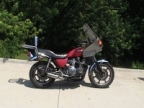rear master cylinder
- Godfrey
-
 Topic Author
Topic Author
- Offline
- User
- Posts: 210
- Thanks: 10
rear master cylinder
13 Jun 2011 07:56
G morning, I'm having an issue with my rear brake not releasing fully as I ride, I rebuilt the caliper last winter, and there didn't seem to be any issues with that.Plus when the brake starts sticking and getting hot I can crack open the bleeder and it immediately releases. The master cylinder I have has the separate reservoir. and as I understand has a small passage that is supposed to be open when there is no foot pressure on the brake pedal to provide the pressure relief I am not getting. The only access that I can find to check if its clear is the rubber plug that supplies the fluid and even with the c clip removed it doesn't want to budge. Is there some method someone knows to remove this plug so I can get to that passage to be sure its clear?
Ty in advance ,
Godfrey
Ty in advance ,
Godfrey
1981 650CSR frame
1980 KZ750E engine
1980 KZ750E engine
Please Log in or Create an account to join the conversation.
- Patton
-

- Offline
- KZr Legend
- Posts: 18640
- Thanks: 2100
Re: rear master cylinder
13 Jun 2011 12:07
As known, brake push rod "length" is adjustable.
If not already done, would assure sufficient gap is provided between end of brake push rod and m/c piston when adjusting the push rod.
Good Fortune!
If not already done, would assure sufficient gap is provided between end of brake push rod and m/c piston when adjusting the push rod.
Good Fortune!
1973 Z1
KZ900 LTD
KZ900 LTD
Please Log in or Create an account to join the conversation.
- Godfrey
-
 Topic Author
Topic Author
- Offline
- User
- Posts: 210
- Thanks: 10
Re: rear master cylinder
13 Jun 2011 21:27
Ty Patton, I did have the adjustment rod pretensioning the MC, and after looking at the cross section diagram in the service manual I can see where that would put the primary cup covering the return passage. I have a lil more pedal travel then I like , but the brake isn't heating like it was so I'll deal with it.
Ed
Ed
1981 650CSR frame
1980 KZ750E engine
1980 KZ750E engine
Please Log in or Create an account to join the conversation.
- MFolks
-

- Offline
- User
- Posts: 6650
- Thanks: 540
Re: rear master cylinder
13 Jun 2011 22:08
I believe just like the front master cylinder reservoir, your rear one should have two (2) small holes in the bottom of the brake fluid housing. One of more may be clogged,a wooden toothpick should be able to dislodge the blockage, if not, I'd recommend a fluid change.
Also read this:
Re:KZ1000 rear caliper
BSKZ650 wrote:
Also read this:
Re:KZ1000 rear caliper
BSKZ650 wrote:
"seems to me like you should fix it right,"
I agree. The stuck piston will probably migrate back out and you'll have a sticky caliper again.
"I like to go with DOT 5 fluid when I rebuild the brakes, just a better product"/quote]
Maybe not better, but certainly different. An alarm went off in my brain, so I Googled this up.
"More than you ever wanted to know about brake fluid....
Brake fluid facts
By Steve Wall
As a former materials engineering supervisor at a major automotive brake system supplier, I feel both qualified and obligated to inject some material science facts into the murky debate about DOT 5 verses DOT 3-4 brake fluids. The important technical issues governing the use of a particular specification brake fluid are as follows:
Fluid compatibility with the brake system rubber, plastic and metal components.
Water absorption and corrosion.
* Fluid boiling point and other physical.
* Brake system contamination and sludging.
Additionally, some technical comments will be made about the new brake fluid formulations appearing on the scene.
First of all, it's important to understand the chemical nature of brake fluid. DOT 3 brake fluids are mixtures of glycols and glycol ethers. DOT4 contains borate esters in addition to what is contained in DOT 3. These brake fluids are somewhat similar to automotive anti-freeze (ethylene glycol) and are not, as Dr. Curve implies, a petroleum fluid. DOT 5 is silicone chemistry .
Fluid Compatibility
Brake system materials must be compatible with the system fluid. Compatibility is determined by chemistry, and no amount of advertising, wishful thinking or rationalizing can change the science of chemical compatibility. Both DOT 3-4 and DOT 5 fluids are compatible with most brake system materials except in the case some silicone rubber external components, such as caliper piston boots, which are attacked by silicon fluids and greases.
Water absorption and corrosion
The big bugaboo with DOT 3-4 fluids always cited by silicone fluid advocates is water absorption. DOT 3-4 glycol based fluids, just like ethylene glycol antifreezes, are readily miscible with water. Long term brake system water content tends to reach a maximum of about 3%, which is readily handled by the corrosion inhibitors in the brake fluid formulation. Since the inhibitors are gradually depleted as. Since the inhibitors are gradually depleted as they do their job, glycol brake fluid, just like anti-freeze, needs to be changed periodically. DOT 5 fluids, not being water miscible, must rely on the silicone (with some corrosion inhibitors) as a barrier film to control corrosion. Water is not absorbed by silicone as in the case of DOT 3-4 fluids, and will remain as a separate globule sinking to the lowest point in the brake system, since it is more dense.
Fluid boiling point
DOT 4 glycol based fluid has a higher boiling point ( 446°F) than DOT 3 ( 446 ºF), and both fluids will exhibit a reduced boiling point as water content increases. DOT 5 in its pure state offers a higher boiling point (500°F) however if water got into the system, and a big globule found its way into a caliper, the water would side at temperatures very much below freezing, let alone at 40° below zero, silicone's low temperature advantage won't be apparent. Neither fluids will reduce stopping distances.
With the advent of ABS systems, the limitations of existing brake fluids have been recognized and the brake fluid manufacturers have been working on formulations with enhanced properties. However, the chosen direction has not been silicone. The only major user of silicone is the US Army. It has recently asked the SAE about a procedure for converting from silicon back to DOT 3-4. If they ever decide to switch, silicone brake fluid will go the way of leaded gas.
Brake system contamination
The single most common brake system failure caused by a contaminant is swelling of the rubber components (piston seals etc.) due to the introduction of petroleum based products (motor oil, power steering fluid, mineral oil etc.) A small amount is enough to do major damage. Flushing with mineral spirits is enough to cause a complete system failure in a short time. I suspect this is what has happened when some car owners changed to DOT 5 (and then assumed that silicone caused the problem). Flushing with alcohol also causes problems. Older brake systems should be flushed only with DOT 3 or 4.
If silicone is introduced into an older brake system, the silicone will latch unto the sludge generated by gradual component deterioration and create a gelatin like goop which will attract more crud and eventually plug up metering orifices or cause pistons to stick. If you have already changed to DOT 5, don't compound your initial mistake and change back. Silicone is very tenacious stuff and you will never get it all out of your system. Just change the fluid regularly. For those who race using silicone fluid, I recommend that you crack the bleed screws before each racing session to insure that there is no water in the calipers.
New developments
Since DOT 4 fluids were developed, it was recognized that borate ester based fluids offered the potential for boiling points beyond the 446°F requirement, thus came the Super DOT 4 fluids - some covered by the DOT 5.1 designation -which exhibit a minimum dry boiling point of 500°F (same as silicone, but different chemistry).
Additionally, a new fluid type based on silicon ester chemistry (not the same as silicon) has been developed that exhibits a minimum dry boiling point of 590°F. It is miscible with DOT 3-4 fluds but has yet to see commercial usage."
I learned in the past thru others mistakes not to switch to DOT 5 in systems designed for DOT 3 or 4.
1982 GPZ1100 B2
General Dynamics/Convair 1983-1993
GLCM BGM-109 Tomahawk, AGM-129A Advanced Cruise Missile (ACM)
General Dynamics/Convair 1983-1993
GLCM BGM-109 Tomahawk, AGM-129A Advanced Cruise Missile (ACM)
Please Log in or Create an account to join the conversation.
- ELCouz
-

- Offline
- User
- Posts: 381
- Thanks: 5
Re: rear master cylinder
06 Jul 2011 22:38
Just want to add a correction...
Many car builder for shows use DOT5 fluid. The major advantage (and why we still have it on the shelf) is that it won't eat your 1 zillion $ paint job on your car! Trust me I've bleeded brakes a lot... If a little spill happens, if you are lucky and quick you might wipe it so fast that damage is minimal...minute or two clearcoat and if unlucky paint is starting to dissolve!
Put a towel on my gas tank when bleeding front brake a little squirt got out high in the air and hit the uncovered gas tank on the other side... damn need a new paint job!
Sometimes this is a major thing for people build car or motorcycle based on appearance!
regards,
laurent
However, the chosen direction has not been silicone. The only major user of silicone is the US Army. It has recently asked the SAE about a procedure for converting from silicon back to DOT 3-4. If they ever decide to switch, silicone brake fluid will go the way of leaded gas.
Many car builder for shows use DOT5 fluid. The major advantage (and why we still have it on the shelf) is that it won't eat your 1 zillion $ paint job on your car! Trust me I've bleeded brakes a lot... If a little spill happens, if you are lucky and quick you might wipe it so fast that damage is minimal...minute or two clearcoat and if unlucky paint is starting to dissolve!
Put a towel on my gas tank when bleeding front brake a little squirt got out high in the air and hit the uncovered gas tank on the other side... damn need a new paint job!
Sometimes this is a major thing for people build car or motorcycle based on appearance!
regards,
laurent
1982 KZ810-R1 GPZ with hindle 4-into-1 pipe
Please Log in or Create an account to join the conversation.
